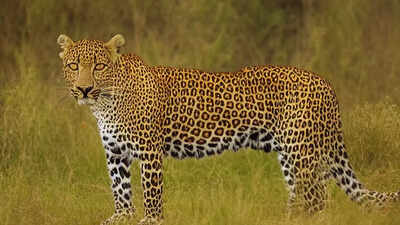Trending Topics
Rise in leopard density leads to more attacks in Maharashtra

Representative image
PUNE: The number of leopard attacks on humans across the four tehsils in Junnar forest division has gone up to 27 so far this year as against five in the corresponding period last year.
Junnar deputy conservator of forest Amol Satpute said, "Three of the 27 attacks this year have resulted in deaths. A factor behind the rise in the attacks is a significant rise in the density of the leopard population in the four tehsils - Ambegaon, Khed, Junnar and Shirur."

"On an average, six to seven leopards move around in a 100sq km area. Considering the Junnar forest division's spread of 5,800sq km, an estimated 350 leopards constitute the population in the four tehsils. Availability of shelter, sugar cane fields, water and prey has contributed to the rising density of the wild animal," he added.
Besides, the forest authorities have certain limitations in keeping the trapped leopards in captivity at the Manikdoh leopard rehabilitation centre. The facility can accommodate 35 leopards at any given time. The authorities have to release some of the leopards into the wild forest post-rehabilitation. " We cannot keep the animal at the rehabilitation centre for a long time as they may struggle to survive in the forest ," Satpute added. The release of the animal has become a tricky exercise in the past few years. "We cannot free animals in the new areas, as they might not be able to find water sources and prey in the new area. This often results in man-animal conflict," said Satpute.
Junnar deputy conservator of forest Amol Satpute said, "Three of the 27 attacks this year have resulted in deaths. A factor behind the rise in the attacks is a significant rise in the density of the leopard population in the four tehsils - Ambegaon, Khed, Junnar and Shirur."

"On an average, six to seven leopards move around in a 100sq km area. Considering the Junnar forest division's spread of 5,800sq km, an estimated 350 leopards constitute the population in the four tehsils. Availability of shelter, sugar cane fields, water and prey has contributed to the rising density of the wild animal," he added.
Besides, the forest authorities have certain limitations in keeping the trapped leopards in captivity at the Manikdoh leopard rehabilitation centre. The facility can accommodate 35 leopards at any given time. The authorities have to release some of the leopards into the wild forest post-rehabilitation. " We cannot keep the animal at the rehabilitation centre for a long time as they may struggle to survive in the forest ," Satpute added. The release of the animal has become a tricky exercise in the past few years. "We cannot free animals in the new areas, as they might not be able to find water sources and prey in the new area. This often results in man-animal conflict," said Satpute.
Start a Conversation
FOLLOW US ON SOCIAL MEDIA
FacebookTwitterInstagramKOO APPYOUTUBE










